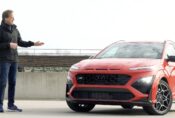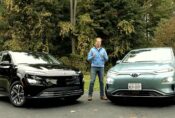2013 Hyundai Santa Fe Sport AWD 2.0T
With the departure of the 7-passenger Veracruz, Hyundai is capitalizing on the popular Santa Fe name to help re-launch its most spacious vehicle. So this 5-passenger model, similar in size to the outgoing Santa Fe, is called the Sport. And you can have it in a couple of different configurations. The base model is powered by a 2.4-liter 4-cylinder making 190 horsepower while this more potent model gets a 2.0-liter turbo generating 264 horsepower. Front or all-wheel drive can be specified on either and a 6-speed automatic is the only transmission offering. V6 power is reserved for the larger Santa Fe.
Hyundai propagates their fluidic sculpture design to yet another vehicle and takes it a step further with a new design concept called Storm Edge…intended to capture the strong and dynamic images created by nature during the formation of a storm. However you interpret it, the look is a winner blending sophistication and athleticism with LED headlight accents that cause a stir at night. 19” wheels riding on new-to-market Continental CrossContact LX Sport tires, twin-tip chrome exhaust and the chrome grille all lend to its upscale attractiveness.
After living with the Santa Fe Sport for a week, it’s most redeeming attributes stem from its generous size, flexibility and cargo cleverness. Most manufacturers miss the boat when it comes to offering more than just a big box cargo area, but Hyundai has under floor divided storage areas and a unique way to stow the cargo cover and net when not in use. The over 35 cubic feet behind the 2nd row is greater than that of a Ford Edge and the seats drop with a convenient lever system. People in the rear seats, even three across, will find plenty of stretch-out room thanks to sliding and reclining seats and hey, they’re even heated. Maximum towing is also a selling point at 3,500 pounds, again besting the Edge…a key Santa Fe Sport rival according to Hyundai. My tester is equipped with torque-vectoring all-wheel drive which comes with a lock mode as well as Hillstart assist and downhill brake control. So as far as the utility angle goes, this crossover gets an A+.
What sadly is lacking once again in a Hyundai vehicle is better steering feel. Even with this driver selectable setup, controlled through a button on the wheel, none of the 3 modes delivers tangible differences beyond variable effort. This is where the Santa Fe Sport loses some of its driver connectedness which can really elevate the way the driver perceives the overall driving experience. The turbo is very strong and the powertrain in general is quite pleasing and polished in its operation. Gas mileage is rated at favorable 19mpg city/24mpg highway but a relatively small 17 gallon tank means you’ll have to stop a little more frequently.
I was expecting to be wowed by something new in here and I really wasn’t. The center stack drew criticism all week for its cheap looking switches and tiny media screen. In fairness, the optional tech package provides a real navi unit with larger screen. BlueLink, which comes free for up to a year, uses your smartphone to bring OnStar like driving directions and information to the vehicle, and while it works pretty well this entire setup seems out of place in a $33,000 crossover. That tech package should be standard if Hyundai wants to continue its power-to-surprise ways. The ride quality also skews too firm in a vehicle type where occupant comfort should be paramount.
A base Santa Fe Sport starts at around $25,000 and comes well equipped like this with the leather and premium package for $33,055. It’s a solid entry but doesn’t quite hit all of its intended marks.

 2023 HYUNDAI PALISADE TEST DRIVE
2023 HYUNDAI PALISADE TEST DRIVE 2022 HYUNDAI KONA N TEST DRIVE
2022 HYUNDAI KONA N TEST DRIVE 2022 HYUNDAI KONA ELECTRIC TEST DRIVE
2022 HYUNDAI KONA ELECTRIC TEST DRIVE